Chlortetracycline colloidal gold rapid detection card is a rapid detection product based on immunochromatography technology in the field of food safety testing. It is mainly used for qualitative or semi-quantitative detection of chlortetracycline residues in foods (such as meat, aquatic products, dairy products, etc.). It uses the principle of specific binding of antigens and antibodies to label chlortetracycline monoclonal antibodies with colloidal gold particles. When the sample (such as sample extract) is dripped into the detection card and added to the sample hole, it diffuses to the other end under capillary action. If the sample does not contain chlortetracycline or the content is below the detection limit, the labeled antibody will bind to the antigen on the detection line (coated chlortetracycline-BSA conjugate), and a red band will be formed on the detection line and the quality control line (coated sheep anti-mouse IgG), and the result is negative; if the content of chlortetracycline in the sample reaches or exceeds the detection limit, the labeled antibody will compete with chlortetracycline to bind the detection line antigen, resulting in no band on the detection line, and the quality control line is colored, and the result is positive.
The detection card is mainly composed of sample pad, binding pad, nitrocellulose membrane, absorbent pad and PVC plate. The sample pad is used to pretreat the sample, combined with the pad to adsorb the labeled colloidal gold antibody, the nitrocellulose membrane is the core reaction zone (including the detection line and the quality control line), the absorbent pad provides capillary suction, and the PVC plate plays a supporting role. Compared with traditional detection methods (such as high performance liquid chromatography, mass spectrometry, etc.), it has significant advantages: the detection speed is fast, usually 10-15 minutes to produce results; the operation is simple, no professional instruments and complex operation procedures are required, and non-professionals can master it after simple training; the cost is low, suitable for large-scale rapid screening; the sensitivity is high, and it can reach the μg/L level, which can effectively identify low-concentration residues.
In practical applications, chlortetracycline colloidal gold rapid detection card is widely used in the raw material acceptance process of food production enterprises, which can quickly eliminate raw materials containing high residues; market supervision departments in daily sampling, with the help of this tool can realize on-site rapid screening of farmers' markets and catering units, and timely detection of illegal products; in the breeding process, it can also be used for monitoring the withdrawal period after the use of veterinary drugs in livestock, poultry and aquaculture to avoid the risk of residue exceeding the standard. Its appearance has greatly improved the regulatory efficiency of veterinary drug residues in food, and provided important technical support for ensuring public dietary safety.


